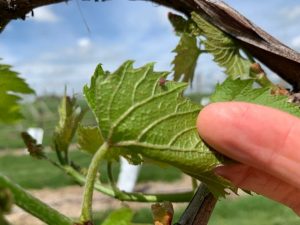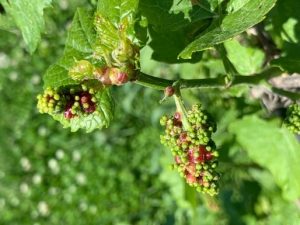Grape Scouting Report: Galls

The grapes at the West Madison Research Station (WMARS) vineyard showed the presence of a few grape phylloxera galls on 6/11/20 (Fig 1). Grape phylloxera galls should be treated with an insecticide such as Movento, Assail, Danitol, Platinum or Scorpion especially if you have a history of phylloxera in your vineyard. Avoid spraying any insecticides during bloom. While grape is wind pollinated, there are bees visiting grape flowers during bloom and it is important to protect our pollinators.

I also had some reports of grape tumid gall makers. When using Integrated Pest Management, the first step is to identify the cause of the damage. As I mentioned in the last issue, you can differentiate galls made by grape phylloxera (Fig 1) from those made by grape tumid gall maker (Fig 2) by looking at the surface of the galls. The grape tumid gall maker makes galls that have a smooth surface and can be anywhere on the plant, i.e., on the cane, rachis, in the grape bunch (as seen in Fig 2), or on the leaves. The galls made by the grape phylloxera are bumpy or warty and found on the leaves (or roots). Both can be controlled with Movento which is a systemic insecticide that will penetrate the waxy leaf surface, with the help of a penetrating adjuvant, and be translocated throughout the plant and reach the insects within the galls. Grape tumid gall maker local infestations can also be managed by simply clipping out the infested tissue and removing it from the vineyard.
Thanks to Beth Workmaster for scouting at WMARS.
Happy growing season!
This article was posted in Grapes, Insects and tagged grape phylloxera, grape scouting, Grapes, phylloxera galls.
